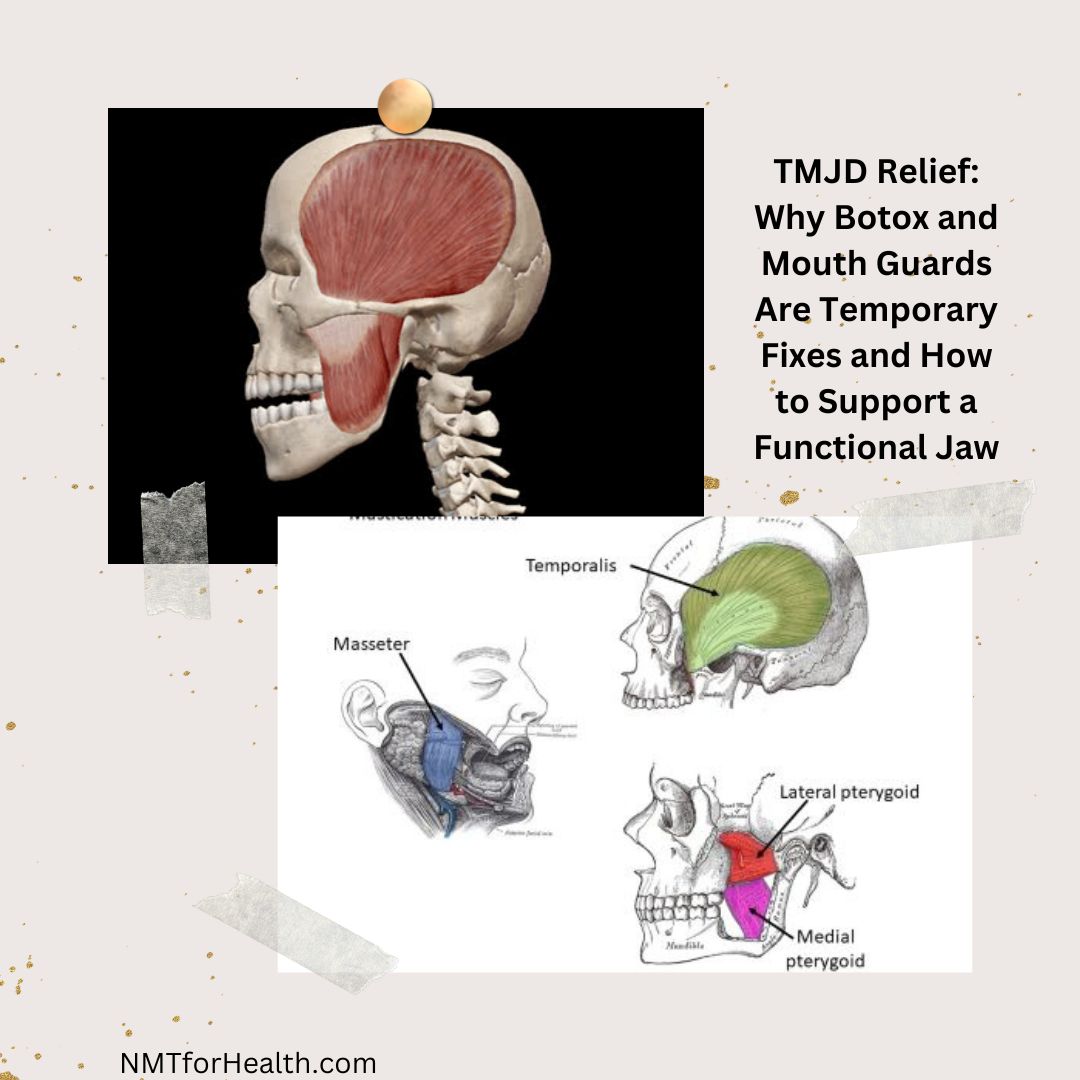Discover sustainable TMJ & TMD relief and how natural stability supports jaw health, breathing, and movement for lasting relief.
The Bigger Picture: TMJ and Whole-Body Health
TMJ-TMD (Disorders and dysfunctions affecting the joint and its associated structures) affects between 5% and 12% of the population, according to the National Institute of Dental and Craniofacial Research. Notably, TMJ-TMD is at least twice as prevalent in women as in men, with women using supplemental estrogen or oral contraceptives more likely to seek treatment. Some studies suggest the prevalence may be as high as 31% in adults, reflecting the widespread impact of these disorders across different age groups.
Your jaw may play a significant role in chronic tension, disrupted sleep, and even poor posture. While quick fixes like Botox or mouth guards can offer temporary relief, they don’t address the root causes. Achieving natural stability through breathing and functional movement is essential for lasting TMJD relief.
Addressing the Symptoms, Not the System
A new client, already diagnosed with TMD, recently sought relief after years of tension and pain caused by the disorder. She had tried Botox for the first time six months prior to reduce her symptoms, but the pain and limited jaw function returned with increased intensity. Her priority was simple: she wanted to eat comfortably without pain, something that had been a struggle since college
But here’s the bigger picture—this client’s jaw has been compensating for over a decade. Without addressing the underlying dysfunction, her reliance on temporary fixes like Botox is prolonging a cycle of tension and compensation. Over time, these patterns could lead to further joint degeneration, chronic pain, and limited function.
Her story highlights a key reality: Botox and mouth guards don’t improve function or recondition the jaw. They may provide temporary relief, but they don’t address the root causes of dysfunction, leaving your body stuck in unsustainable patterns.
Understanding Jaw Tension Patterns
If you’re experiencing jaw pain, limited function, or even tooth sensitivity, teeth grinding or clenching might be contributing. Common signs include:
- Chewing hard or quickly during meals
- Waking up with jaw tightness or headaches
- Feeling tension around the temples or ears
- Noticing wear on your teeth or gums
These patterns often go unnoticed until they’ve already caused damage. These tension patterns not only affect the jaw but also influence patterns throughout the body.
Why Patterns Matter
Chronic tension patterns don’t develop overnight. They form as the body compensates for imbalances, locking muscles into protective states. Over time, these patterns become so ingrained that they feel “normal.”
For example, you might notice:
- Holding your breath during focused activities (like email apnea)
- Gripping with your feet while standing
- Overusing your quads or clenching your glutes to maintain balance
- Leaning to one side or locking one knee
These compensatory strategies create cycles of tension, inflammation, and fatigue. Pain isn’t just a problem—it’s your body’s way of signaling that something isn’t working. Waiting for pain to develop or relying on quick fixes keeps you in a cycle that’s unsustainable over time.
Look around and you might notice a concerning pattern: many people in their 60s and 70s struggling with arthritis, recovering from hip and knee replacements, or dealing with osteopenia that makes walking difficult. While this may seem like an inevitable part of aging, it doesn’t have to be your future. These conditions often stem from years of compensatory patterns that were never addressed. It’s not about placing blame—most people simply weren’t taught how to create sustainable movement patterns or understand the difference between managing symptoms and building true health. The good news? By understanding and addressing these patterns now, you can take steps toward a more mobile, comfortable future.
Breathing and Stability: A Powerful Combination
How Your Ribcage Works
Think of your ribcage as an accordion. With each breath, it expands and compresses in a smooth rhythm. This movement supports essential systems in your body, including breathing, posture, and overall stability.
Boosting Lymphatic Flow
Your diaphragm acts as a hydraulic pump, driving lymphatic circulation. This helps reduce inflammation and prevents fluid stagnation (Lymphatic Research and Biology, 2015). Proper breathing keeps this system running smoothly, aiding recovery and resilience.
Improving Relaxation Through Vagal Tone
Diaphragmatic breathing activates the vagus nerve, shifting your body from a stressed fight-or-flight state to a calmer rest-and-digest mode (Frontiers in Psychology, 2018). This supports emotional recovery and reduces physical tension.
Activating Core Stability
When you naturally breathe, your body naturally engages deep core muscles to support itself. This process doesn’t rely on clenching or gripping. Instead, it provides stability in movements like standing on one leg, where your core supports your body over the leg. Without proper engagement, compensatory patterns, such as gripping with your feet or overworking your legs, take over, leading to tension and imbalance. Proper breathing improves trunk control, reduces strain on the lower back and hips, and allows your body to stack naturally (International Journal of Sports Physical Therapy, 2016).
Why Jaw and Breathing Alignment Matters
When your jaw and breathing are in sync, your body finds balance more easily. This connection creates a foundation for stability and movement that feels natural and effortless. It’s not just about breathing—it’s about improving how your body functions as one coordinated system.
The Hip-Jaw Connection
Your jaw and hips are connected through the spine and overall posture. When your hips are unstable or restricted, it often forces your jaw to compensate by tightening. This connection becomes especially noticeable in movements like walking or standing on one leg, where hip stability directly impacts jaw tension. By addressing these patterns, you can reduce strain on your jaw and improve overall functional movement.
Bringing It All Together
When the body is stuck in a fight-or-flight state, shallow chest breathing takes over, reinforcing tension in the neck, shoulders, and jaw. This disrupts the phrenic nerve’s connection to the diaphragm, reducing its ability to work as a hydraulic pump for the lymphatic system. Redirecting effort to your deep core through the Align & Breathe technique helps reset these patterns. By promoting natural stability, it allows your neck, hips, and jaw to relax, restoring alignment and function.
Functional Tools and Foundational Movements Over Temporary Fixes
Foam rollers and tennis balls might offer momentary relief, but they rarely address the patterns causing the tension. Research shows that while these approaches are popular, they often fail to recondition the body’s neuromuscular systems or improve long-term stability (Journal of Athletic Training, 2008).
Tools like the Bosu, balance pad, and resistance bands, on the other hand, actively engage stabilizing systems, retrain movement patterns, and enhance proprioceptive feedback, which are essential for functional recovery (Journal of Athletic Training, 2008). By eliminating dysfunctional patterns and building resilience, these tools provide lasting results instead of temporary fixes.
Foundational movements—such as controlled single-leg stances, gentle core activations, and balance-focused exercises—reinforce stability by engaging the deeper muscles that support alignment and movement. These tools and movements work together to actively restore functional patterns, promoting natural core engagement without clenching or overcompensation.
Rather than chasing pain with quick fixes, this integrated approach retrains your body to eliminate dysfunctional patterns, reduce chronic pain, and build overall resilience. By focusing on stability, alignment, and natural movement, you set the stage for sustainable health and functional recovery.
Notice Your Patterns: The One-Leg Test
Take a moment to observe:
- Are you leaning more heavily to one side?
- Are your feet gripping the ground for balance?
- Is one knee overworking or locked, signaling a lack of hip or core support?
- Does your ribcage expand and move naturally when you breathe?
- Do you feel the same on both sides of your body, or is one side compensating?
This is known as the Trachtenberg Test, a simple yet insightful tool to evaluate balance and natural stability patterns. Chronic patterns not only influence pain but also lead to fatigue and tension that builds over time.
These observations are about understanding your body’s story—becoming aware of where chronic patterns are creating imbalances. These patterns not only influence pain and contribute to TMJ/TMD but also lead to fatigue and tension that builds over time.
Your ability to balance, especially on one leg, tells an important story about how you’re using your body. This isn’t just about the present moment—it’s a critical indicator of how well you’ll be able to prevent falls in the future. The patterns you develop today either support your long-term stability or contribute to repetitive strain and breakdown. The good news is that this story can be changed when you understand what your body is telling you.
The Fight-or-Flight Cycle and Chronic Pain
Chronic pain often stems from the body’s prolonged fight-or-flight response, where stress keeps your muscles locked into tension. This heightened state not only perpetuates dysfunctional movement patterns but also impacts your ability to recover, absorb nutrients, and maintain energy.
Breaking this cycle through breathing and functional movement helps shift your body into a rest-and-digest state, promoting recovery and reducing inflammation.
Hope for Long-Term Relief
Align & Breathe isn’t just about breathing—it’s about retraining your body to move and function in a way that supports longevity. Progress takes time, but every small shift in how your body moves and breathes is a step toward sustainable health.
Pain is not your enemy—it’s your body’s way of asking for change. Together, we can go beyond temporary fixes and create patterns that support your health for years to come.
Remember: Your jaw isn’t just about chewing—it’s a window into your body’s overall function and balance.
Stay Connected for More Insights
Looking for practical tips and exercises to support your journey?
- Follow me on TikTok: This is my Balance Journal, where I share real-time insights and notes from my own practice.
- Check out my Instagram: Dive deeper into the educational side with demonstrations and guidance to help you progress further.
Related articles:
- The Role of Proprioception and Balance Training in Chronic Pain Relief
A study published in the Journal of Athletic Training found that proprioceptive and balance training not only improved joint stability but also reduced the risk of chronic injuries by reconditioning the body’s neuromuscular control systems. Incorporating tools like the Bosu and balance pad into therapy can enhance proprioceptive feedback and help reset compensatory patterns.
(Source: Journal of Athletic Training, 2008) - Breathing Patterns and Core Stability
Research in the International Journal of Sports Physical Therapy highlights the connection between diaphragmatic breathing and core stability. It suggests that synchronized breathing during movements improves trunk control and reduces compensatory strain in the lower back and hips, leading to better functional outcomes for individuals with chronic pain.
(Source: IJSPT, 2016) - The Benefits of Resistance Band Training for Functional Movement
A review in the Journal of Strength and Conditioning Research emphasizes the effectiveness of resistance bands in activating stabilizing muscles, especially in the hips and shoulders. This type of training can address imbalances caused by prolonged compensatory patterns and improve functional alignment.
(Source: JSCR, 2013) - The Impact of Chronic Stress on Movement Patterns
Research in Frontiers in Human Neuroscience explores how chronic stress alters movement patterns, often reinforcing shallow breathing and increased muscle tension. Tools and techniques that promote deep, controlled breathing and stability exercises were found to reduce stress-induced movement dysfunction and improve overall alignment.
(Source: Frontiers in Human Neuroscience, 2018) - The Hydraulic Pump Function of the Diaphragm in Lymphatic Flow
Studies in Lymphatic Research and Biology explain the role of the diaphragm as a hydraulic pump, driving lymphatic circulation and reducing stagnation. Functional breathing exercises, paired with tools like the balance pad, enhance this natural process, reducing inflammation and supporting recovery from chronic pain.
(Source: Lymphatic Research and Biology, 2015)

